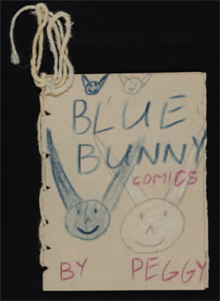Events
October 27, 2010
Atwood entrances with warm humor and cool intellect

FLYING RABBITS: Margaret Atwood shared one of her earliest books with Ellmann Director Joseph Skibell.
Science is about knowledge, while fiction is about feeling, said Margaret Atwood. The prolific author of poetry, fiction and nonfiction was on campus Oct. 24-26 to deliver the 10th series of the Richard Ellmann Lectures in Modern Literature.
In introductory remarks, Ellmann Lectures Director Joseph Skibell said Margaret Atwood belongs to the category of artists who constantly reinvent themselves out of a burning sense of curiosity.
With characteristic humor, Atwood told the capacity audience in Glenn Auditorium: “I write fiction and poetry, but this has not made me a professional scholar on any subjects, including those I’m about to discuss.”
She then delivered a three-day series of three original lectures, proving that she is not only a scholar but also an accomplished observer of literary history and methodology.
Fantasy world of childhood
In an Oct. 24 talk titled “Flying Rabbits,” Atwood described her childhood and the genesis of her art. Growing up in the Canadian north, in a home with no furnaces, television, flush toilets, movies, theater or libraries, she and her brother began reading and writing early, developing fantasy worlds populated by superhero flying rabbits. A slide show illustrated both her environment and some early examples of her writing and illustration.
She acknowledged an early taste for comic strips, mythology and fairy tales, especially the Brothers Grimm—“the unexpurgated one, with pecked-out eyeballs. Parents wrongly think kids don’t like those kinds of things. I did!”
Were her superheroes science fiction? It all depends, she said, on your nomenclatural allegiances. She didn’t know what “science fiction” meant. Is it a genre or a shelving aid for bookstores? Do silver clothes and flames, dragons or things taking over your body, spaceships, mad scientists or experiments gone horribly wrong make science fiction?
Jules Verne’s influence
She writes what she calls speculative fiction—a genre descended from Jules Verne, as in her newest work. “The Year of the Flood” is set in our world, in a future, a possible one, with things that could happen.
In the second lecture, “Burning Bushes” on Oct. 25, Atwood described her teenage and college years, when her literary preferences included Sir Arthur Conan Doyle, H.G. Wells and Ray Bradbury. She also confessed a taste for campy, low-budget science fiction movies.
What are stories? she asked. Where did they come from? Who listens to them and why? Do they free the imagination or tie it up in chains? Do we tell stories to save our own lives, or are they just a pastime? In proto-humans, perhaps, the ability to tell stories gave those with the talent a better chance of survival.
Science fiction’s purpose
One of her teachers, Canadian literary critic Northrop Frye, taught Bible literature as mythology, stories of a certain kind that a culture takes seriously. Jokes and anecdotes, fables, gossip and folktales needn’t be believed, but our histories do affect how we feel about ourselves, especially in relation to the world, Atwood said.
Explaining science fiction, she said that the name is two terms, often seen as mutually exclusive. “Science” is demonstrable facts, while “fiction” is purely invented and can speak of the past, the passing and the time to come.
Nobody can predict the future; there are too many variables.
But science fiction can explore parallel realities that don’t exist, consequences of new and imagined technologies, pushing the human envelope.
Maps and monsters
In her third lecture Oct. 26, Atwood explored “Dire Cartographies,” the unknown and how we map it. Monsters live at the edges of conscious, she said. With every map, there is an edge—a border between the known and the unknown, where dragons and monsters lurk.
Maps are frozen time—journeys of the past, present and future, and inner journeys taken in imaginary places, places we love inventing, she said. Atwood calls her own invented places “ustopias,” combinations of utopias and dystopias.
In discussing “The Handmaid’s Tale,” Atwood described that writing it gave her “a strange feeling, like sliding on river ice. How thin is the ice on which modern liberated women stand?” When she wrote the book, it wasn’t reality. Now, she said, she wonders.
In a final session, Atwood read from her poetry and her latest book and sang a song from the same workto close her set of lectures.
Quick Links
File Options
Related Information
Video and audio files of Atwood’s lectures and the reading will be available through iTunes U: The Richard Ellmann Lectures on Emory iTunes U.
- Mythology meets science in Atwood's Ellmann lectures (Emory Report, Oct. 21, 2010)
- Creativity: Art and Innovation: The Ellmann Effect
